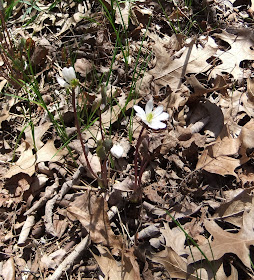I am not a botanist, just a wildflower lover. I try to remember to add the scientific name to these blogs because I know that a lot of plants have different common names from area to area.
I have missed seeing Twinleaf for several years. It is another of the ephermals with a short blooming season. I was pleased when a fellow artist called me to say she had seen it blooming at Stillwater Prairie Reserve. The next day was rainy but the following day, April 12, Tom and I made the trip to the county park. However, the day was dreary, cool and overcast. Rain fell shortly after I took this photograph. Twinleaf must be like Spring Beauty and Bloodroot which close when rain is eminent.
Tom and I returned on April 13, a sunny day, and the flowers were open. Notice that the leaves are still not open and green.
On April 20, the bloom was gone and the leaves were in various stages of opening to display the two lobes which give the plant its name. The seedpod is well on its way to complete development. Donald Cox, in Common Flowering Plants of the Northeast, reports that the mature seeds in the pod have fleshy appendages on one side which may be so the seeds can be dispersed by ants.
According to two online sources, USDA Forest Service and www.wildflower.org/plants, William Bartram, a botanist friend of Thomas Jefferson, named the genus. According to my reference book, The History and Folklore of North American Wildflowers, by Tomothy Coffey, the newly named plant was announced by Benjamin Smith Barton at the May 18, 1792 meeting of the American Philosophical Society when Thomas Jefferson was Secretary of State.
Twinleaf is found from New York to Iowa and from Canada to Alabama and Georgia. For some reason, it has not been found in North Carolina. It is Endangered in Georgia and New Jersey and Threatened in Iowa.
The only other species of twinleaf, Jeffersonia dubia,is found in Japan.



No comments:
Post a Comment